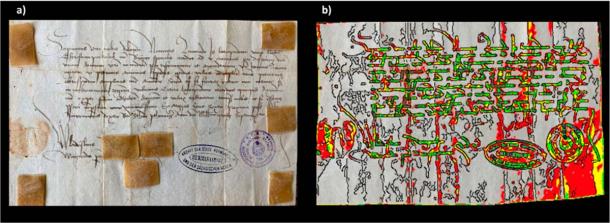Blood
Sadistic Vlad the Impaler Cried Real Tears of Blood, Study Reveals
Vlad Dracul, the infamous medieval Romanian ruler known as Vlad the Impaler and the inspiration for the character of Count Dracula , is considered one of the most bloodthirsty rulers in human history. This identification now seems more apt than ever, as a team of Romanian and Italian chemists has just released a study claiming that Vlad the Impaler literally, and not metaphorically, cried tears of blood.
Research Reveals the Medical Motive Behind Vlad the Impaler’s Tears of Blood
In an article just published in the journal Analytical Chemistry , scientists from the University of Catania, SpringStyle Tech Design Ltd, the Romania National Archives and Politecnico di Milano reported on evidence they uncovered showing that the real-life inspiration for Count Dracula suffered from many illnesses and medical conditions.
The study reveals that his tears of blood were caused by a medical condition that would leak blood into his tear ducts on any occasion where he felt the urge to weep. While not the most serious of his ailments, the most eye-opening of Vlad the Impaler’s disorders was the incredibly rare hemolacria, which causes a person to cry tears that contain actual blood. Those who saw Vlad the Impaler shedding tears of blood might have considered it a reflection of his evil nature rather than seeing it as a medical condition.

A letter dated to 1475 which was analyzed to come to conclusions about the health of Vlad the Impaler. (Analytical Chemistry / CC BY 4.0 )
Letters Reveal the Bloody Tears of the Madman Vlad the Impaler
To learn more about Vlad Dracul’s health, Romanian and Italian scientists performed a chemical analysis of proteins and peptides removed from three letters he wrote in the 15th century. Between 1448 and 1476 the original Prince of Darkness ruled over the lands of Wallachia, which today make up the southern half of the country of Romania.
For the purposes of this new study, the chemists applied a substance known as ethylene-vinyl acetate to the outer surface of the three valuable historical documents written by Vlad the Impaler. This chemical can absorb and transfer proteins and peptides (protein building blocks) from any kind of surface, and in this case these molecules were left on the letters by Vlad when he handled them.
Using this methodology, the scientists were able to remove remaining organic residues that contained over 500 peptides and proteins, of which 100 were human in origin. The peptides were assumed to have come from Vlad the Impaler and not from other individuals who may have handled the letters, since the scientists took samples from areas where a letter writer would be repeatedly touching the paper with the palm and side of the writing hand.
Among the peptides recovered were a type of molecule associated with a group of cellular disorders known as ciliopathies. These troublesome conditions can cause malfunctioning of the organs and lead to the development of many debilitating and painful symptoms of illness.
Other peptides revealed that Vlad the Impaler also had an infection of the respiratory tract at the time he was handling at least one of the letters. This condition may have been temporary, like a cold or the flu, or it could have been a chronic condition that he struggled with for years.

A second letter, also from 1475, including the signature of Vlad the Impaler in the bottom left. On the right as seen under flash UV illumination, a technique which proved that he suffered from a medical condition which made him cry tears of blood. (Analytical Chemistry / CC BY 4.0 )
How Science Reveals Evidence About Vlad the Impaler’s Tears
But the most significant discovery from the perspective of the modern observer came from a letter Vlad the Impaler wrote in 1475. From this one the chemists were able to extract samples of three peptides that came from the retina and the fluid of tears.
It isn’t known exactly why Vlad would have been crying while writing this letter. But it seems he was, and his tears fell onto it and left behind these chemical traces. Based on the unusual properties of these peptides, the scientists reached the astounding conclusion that Vlad’s must have suffered from hemolacria, in which varying quantities of blood will flood the tear ducts and mix with tears.
This condition is ultra-rare, which is why it is so remarkable to discover that a person well-known in history actually had it. And not just any person, but the man who was the real-life version of literature and film’s most famous blood-drinking vampire.
From studying eye secretions alone, the scientists were not able to diagnose the underlying cause of the hemolacria. This condition can develop after a person suffers from bacterial conjunctivitis, or if they have some type of injury to the area close to the tear ducts. In some cases, it can be caused by a tumor in the eye area.
The amount of blood produced by a case of hemolacria can vary greatly from person to person. Some people who get it will cry tears that are only slightly tinged with red, while others will cry tears that are so blood-saturated that they appear dark red.
It certainly would have been appropriate if Vlad the Impaler’s eyes leaked tears the color of pure blood. Vlad’s bleeding eyes revealed his true character and would have undoubtedly struck terror into the hearts of any of his enemies who got close enough to see him crying.

Vlad the Impaler was the the real-life inspiration for Count Dracula. ( rosinka79 / Adobe Stock)
The Horrific Legend of Vlad the Impaler Lives On
This new study represents a breakthrough in Vlad Dracul scholarship. “To our reckoning, this is the first time such research has been carried out and has helped to bring to the limelight the health status of Vlad Dracula the Impaler,” the study authors wrote in their Analytical Chemistry article.
In most instances the health issues of a medieval prince who ruled over an obscure region of eastern Europe for less than three decades wouldn’t generate much public interest. But the exploits of Vlad the Impaler have become the stuff of legend, thanks mainly to the choice by author Bram Stoker to attach his name to a character that introduced the vampire to modern audiences.
Vlad the Impaler was arguably much more bloodthirsty than the fictional Count Dracula . Historians have credited him with the deaths of over 80,000 enemy soldiers and innocent civilians during his struggle to keep Wallachia independent from the Ottoman Empire . The ‘impaler’ label refers to Vlad’s favorite means of execution, which is how the majority of his victims met their demise.
[embedded content]
Events that took place in 1462 reveal the depth of Vlad Dracul’s psychopathic depravity. That year, the Ottoman Empire sultan Mehmed II led an army of 90,000 men toward Wallachia, as part of the sultan’s ongoing efforts to conquer the future lands of Romania and absorb it into his kingdom.
In order to stop the invasion, Vlad the Impaler ordered the impalement of more than 23,000 prisoners his forces had captured during guerrilla raids into Ottoman territory. As Mehmed’s army advanced they were greeted with the horrible sight of these unfortunate souls, including men, women and children, impaled on stakes lining the route to Wallachia. Totally sickened by what they saw, Mehmed’s army turned around and headed back to Constantinople, so that Vlad would stop what he was doing.
In a letter Vlad wrote to the king of Hungary Matthias I, he explained exactly what had happened, in unemotional, matter-of-fact language. His soldiers had “killed peasants, men and women, old and young,” he stated. “We killed 23,884 Turks, without counting those whom we burned in homes or the Turks whose heads were cut by our soldiers.” To back up his claims, Vlad produced sacks filled with body parts that had been cut off his victims.
In actual fact none of the men, women and children who Vlad decided to execute were Ottoman Turks. They were innocent Serbian and Bulgarian civilians whose peoples had been conquered by the Ottomans and who had no affection for their occupiers.
If Vlad the Impaler cried tears of blood after these events, he would have been doing so in joy, not in sorrow, delighted to know that his efforts to intimidate the Ottoman Empire forces had worked. Perversely, the terrible nature of Vlad Dracul’s deeds are what have made him a legend, and Bram Stoker’s incredibly influential 1897 novel and the lead character he created ensured that this true Prince of Darkness would never be forgotten.
Top image: Vlad the Impaler cried real tears of blood. Source: Lama9838/ CC BY-SA 3.0
By Nathan Falde
